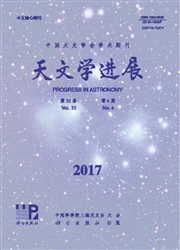

 中文摘要:
中文摘要:
对于星系际弥散恒星的研究是分别从观测、数值模拟和半解析模型这三个方面进行的。现在已经在邻近星系团及中低红移处观测到弥散恒星,甚至在Virgo及Coma星系团中观测到了单个的弥散恒星。观测数据的积累使得人们能够从统计上了解星系际弥散恒星的性质。研究表明星系际弥散恒星围绕着星系团势阱中心呈椭球状对称分布,其在星系团恒星总质量中所占比例在10%-30%的范围内,和星系团总质量的关系不大,但是和星系团的富集程度有很大的相关,如在一个像Coma这样恒星富集度比较高的星系团中,这个比例能够达到40%甚至50%。数值模拟和半解析模型比较成功地预言了弥散恒星的起源和动力学性质,使得人们能够了解弥散恒星是在何时以何种方式形成,与星系团中最亮星系间的关系及其对星系形成模型的影响,从而对宇宙学研究中的恒星形成、星系中重子物质的分布等做出限制。
 英文摘要:
英文摘要:
The concept of intracluster starlight (ICL), or stars between the galaxies in galaxy clusters is not a new one: it was first proposed over 50 years ago. However, progress in studying ICL has been slow due to its low surface brightness, which is less than 1% of the brightness of the night sky. This is unfortunate, because ICL is a powerful probe of the evolution of galaxies in clusters, and of cluster evolution overall. In this paper, we review the progress of the studies on the evolution of ICL using simulation, semi-analytical model (SAM) and observations. In the past decade, the study of ICL has increased dramatically. By taking a deep imaging survey of galaxy clusters with CCD detectors, we are able to measure the ICL to faint surface brightnesses many magnitudes below that of the night sky. ICL has now been observed in nearby and in intermediate redshift clusters. Individual intracluster stars have been detected in the Virgo and Coma clusters and the first color-magnitude diagram and velocity measurements have been obtained. Detections of tidal debris arcs in clusters have shown significant substructure in the ICL, and that the production of ICL is ongoing. Recent studies show that the ICL contains of the order of 10% and perhaps up to 30% of the stellar mass in the cluster, but in the cores of some dense and rich clusters like Coma, the local ICL fraction can be as high as 40% 50%, and with a ellipsoidal symmetrical distribution around the center of potential well of galaxy clusters. In tandem with the observations, high resolution, large-scale, cosmological N-body and hydro- dynamical simulations are now being able to make predictions for the kinematics and origin of the ICL. It is possible to make people understand how and when the ICL formed, how it connects to the central brightest cluster galaxy, and how it affects the formation of galaxy cluster and the evolution of cluster galaxies. Simulation can also constrain the study of cosmology, such as star formation, distribution of baryons in ga
 同期刊论文项目
同期刊论文项目
 同项目期刊论文
同项目期刊论文
 The kinetic power of jets magnetically accelerated from advection-dominated accretion flows in radio
The kinetic power of jets magnetically accelerated from advection-dominated accretion flows in radio COSMOLOGICAL EVOLUTION OF MASSIVE BLACK HOLES: EFFECTS OF EDDINGTON RATIO DISTRIBUTION AND QUASAR LI
COSMOLOGICAL EVOLUTION OF MASSIVE BLACK HOLES: EFFECTS OF EDDINGTON RATIO DISTRIBUTION AND QUASAR LI Influence of baryonic physics on the merger timescale of galaxies in N-body/hydrodynamical simulatio
Influence of baryonic physics on the merger timescale of galaxies in N-body/hydrodynamical simulatio SELF-CALIBRATION OF GRAVITATIONAL SHEAR-GALAXY INTRINSIC ELLIPTICITY CORRELATION IN WEAK LENSING SUR
SELF-CALIBRATION OF GRAVITATIONAL SHEAR-GALAXY INTRINSIC ELLIPTICITY CORRELATION IN WEAK LENSING SUR Exact analytical solution of the linear structure growth rate in Lambda CDM cosmology and its cosmol
Exact analytical solution of the linear structure growth rate in Lambda CDM cosmology and its cosmol First measurement of Mg isotope abundances at high redshifts and accurate estimate of Delta alpha/al
First measurement of Mg isotope abundances at high redshifts and accurate estimate of Delta alpha/al Detecting the intrinsic Baldwin Effect of the optical FeII complex in luminous Seyfert 1 galaxy fair
Detecting the intrinsic Baldwin Effect of the optical FeII complex in luminous Seyfert 1 galaxy fair INTRINSIC ELLIPTICITY CORRELATION OF SDSS LUMINOUS RED GALAXIES AND MISALIGNMENT WITH THEIR HOST DAR
INTRINSIC ELLIPTICITY CORRELATION OF SDSS LUMINOUS RED GALAXIES AND MISALIGNMENT WITH THEIR HOST DAR THE GRAVITATIONAL SHEAR-INTRINSIC ELLIPTICITY CORRELATION FUNCTIONS OF LUMINOUS RED GALAXIES IN OBSE
THE GRAVITATIONAL SHEAR-INTRINSIC ELLIPTICITY CORRELATION FUNCTIONS OF LUMINOUS RED GALAXIES IN OBSE Imprint of the interaction between dark sectors in large scale cosmic microwave background anisotrop
Imprint of the interaction between dark sectors in large scale cosmic microwave background anisotrop The anticorrelation between the hard X-ray photon index and the Eddington ratio in low-luminosity ac
The anticorrelation between the hard X-ray photon index and the Eddington ratio in low-luminosity ac IMAGES OF THE RADIATIVELY INEFFICIENT ACCRETION FLOW SURROUNDING A KERR BLACK HOLE: APPLICATION IN S
IMAGES OF THE RADIATIVELY INEFFICIENT ACCRETION FLOW SURROUNDING A KERR BLACK HOLE: APPLICATION IN S THE VELOCITY FUNCTION IN THE LOCAL ENVIRONMENT FROM Lambda CDM AND Lambda WDM CONSTRAINED SIMULATION
THE VELOCITY FUNCTION IN THE LOCAL ENVIRONMENT FROM Lambda CDM AND Lambda WDM CONSTRAINED SIMULATION Environmental effects on satellite galaxies: the link between concentration, size and colour profile
Environmental effects on satellite galaxies: the link between concentration, size and colour profile EVIDENCE FOR X-RAY SYNCHROTRON EMISSION FROM SIMULTANEOUS MID-INFRARED TO X-RAY OBSERVATIONS OF A ST
EVIDENCE FOR X-RAY SYNCHROTRON EMISSION FROM SIMULTANEOUS MID-INFRARED TO X-RAY OBSERVATIONS OF A ST Modeling Nonlinear Evolution of Baryon Acoustic Oscillations: Convergence Regime of N-body Simulatio
Modeling Nonlinear Evolution of Baryon Acoustic Oscillations: Convergence Regime of N-body Simulatio 期刊信息
期刊信息
